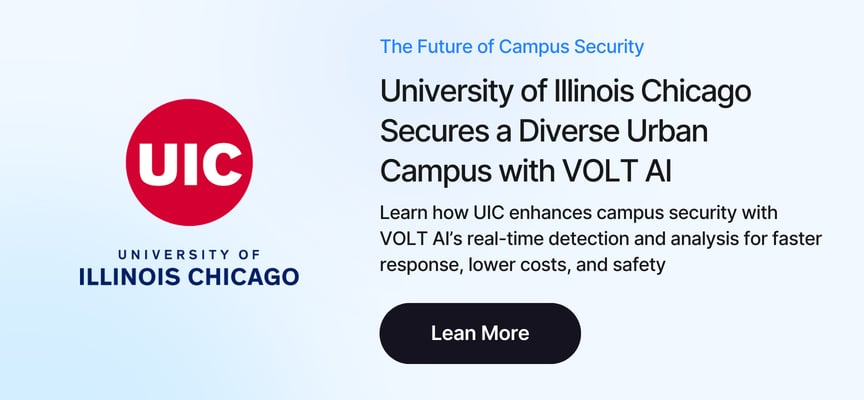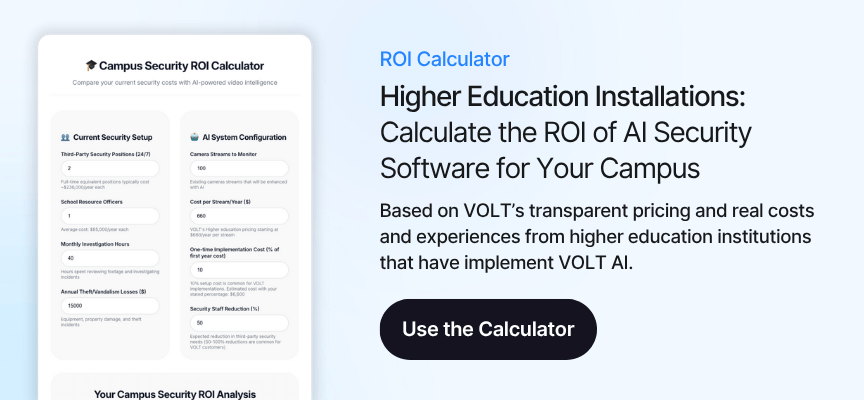Key Points
- Force multiplication through AI detection: Campus security systems powered by AI transform limited personnel into comprehensive 24/7 monitoring capabilities across entire campuses
- Medical emergency response acceleration: Real-time person-down detection enables response times measured in seconds rather than minutes, potentially saving lives during critical health events
- Operational cost reduction through automation: AI-powered monitoring reduces reliance on expensive third-party security contracts by up to 50% while improving coverage quality
- Proactive incident prevention: Fight detection, crowd monitoring, and unauthorized access alerts enable staff to intervene before situations escalate into costly or dangerous incidents
- Data-driven security optimization: Comprehensive incident tracking and analytics provide administrators with actionable insights for resource allocation and policy improvements
What is Comprehensive Campus Security Beyond Weapon Detection?
Campus security encompasses far more than preventing catastrophic incidents. Modern comprehensive campus security includes AI-powered systems that detect medical emergencies, prevent theft, monitor unauthorized access, and identify behavioral anomalies in real-time. These integrated security solutions transform existing camera infrastructure into intelligent monitoring networks that protect students, faculty, and campus assets while delivering measurable returns on investment.
Learn from real campus security leaders implementing AI security.
The Hidden Value of Comprehensive Campus Security
Campus safety professionals understand that weapon detection represents just one piece of a complex security puzzle. While preventing catastrophic incidents remains paramount, the daily operational challenges that impact student safety, institutional liability, and budget efficiency demand equal attention. Modern AI-powered campus security systems deliver measurable returns on investment through consistent detection and response to routine campus incidents that traditional monitoring approaches often miss entirely.
The economics of campus security have fundamentally shifted as institutions grapple with staffing shortages, rising security costs, and increased accountability for student safety. Universities across the country report spending an average of $236,000 annually per third-party security position for 24/7 coverage, yet these investments frequently fail to deliver comprehensive monitoring or consistent performance standards.
Medical Emergencies: When Seconds Determine Outcomes
Medical emergencies on college campuses occur with surprising frequency, yet many institutions lack effective systems for rapid detection and response. AI-powered person-down detection represents a breakthrough in emergency medical response capabilities, transforming how campuses handle critical health incidents.
Traditional campus medical emergency protocols rely heavily on witness reporting or routine security patrols to identify students or staff in distress. This reactive approach introduces dangerous delays that can prove fatal during cardiac events, seizures, severe allergic reactions, or other time-sensitive medical crises.
How AI Transforms Medical Emergency Response
Modern person-down detection systems provide comprehensive monitoring capabilities that transform emergency response effectiveness. These AI-powered campus security solutions analyze video feeds continuously to identify individuals who have fallen or appear motionless in unusual positions.
- Real-time identification enables instant detection without human monitoring fatigue.
- Context analysis distinguishes between normal activities like sitting and genuine medical emergencies.
- Location intelligence factors in area context, time of day, and behavioral patterns to minimize false positives.
- Automated alerting provides immediate notifications to security personnel and emergency responders.
- Continuous coverage monitors all camera-equipped areas 24/7 without staffing limitations.
The University of Illinois Chicago's experience demonstrates the life-saving potential of automated medical emergency detection. Their comprehensive campus security system successfully identified a custodian who had fainted after hitting her head in an elevator lobby, generating immediate alerts that enabled rapid medical response. Without automated detection, this individual might have remained unconscious and undetected for extended periods in a low-traffic area.
Medical Emergency Response Comparison | Traditional Methods | AI-Powered Detection |
Detection Method | Witness reporting, patrol discovery | Automated 24/7 monitoring |
Average Response Time | 8-15 minutes | 15-45 seconds |
Coverage Consistency | Limited by patrol schedules | Continuous across monitored areas |
False Alert Rate | N/A (reactive only) | <5% with human verification |
Documentation Quality | Incident reports only | Complete video timeline and analytics |
Fight Detection: Preventing Escalation Through Early Intervention
Campus violence incidents create significant safety, legal, and public relations challenges for universities. Traditional security approaches rely on witness reporting or chance patrol encounters to identify physical conflicts, often allowing situations to escalate before intervention occurs.
AI-powered fight detection systems analyze video feeds in real-time to identify aggressive behaviors, unusual crowd formations, and physical altercations as they develop. These campus security systems enable security personnel to respond within seconds of conflict initiation, dramatically reducing injury risk and preventing escalation into serious incidents.
Violence Prevention Through Advanced Analytics
Universities implementing comprehensive fight detection report substantial improvements in safety outcomes through proactive intervention capabilities. Behavioral analysis detects aggressive postures and confrontational positioning before physical contact occurs. Crowd monitoring identifies unusual gathering patterns that may indicate developing conflicts. Escalation tracking monitors incident progression to enable appropriate response deployment. Geographic intelligence provides location-specific alert parameters based on historical patterns. Response optimization includes automated dispatch protocols directing nearest personnel to incident locations.
Maryville University's implementation illustrates the practical benefits of proactive violence prevention. Their system detected what appeared to be a physical altercation between two individuals within 21 seconds of the conflict beginning. Security personnel were able to respond rapidly and determine that the incident was actually playful shadow boxing rather than genuine violence.
Universities face substantial financial exposure from campus violence incidents through medical costs, legal liability, disciplinary proceedings, and reputation damage. A single serious assault can result in legal settlements exceeding hundreds of thousands of dollars, while institutional damage from publicized campus violence can impact enrollment and funding for years.
Violence Response Metrics | Traditional Approach | AI-Enhanced Detection |
Average Detection Time | 5-15 minutes | 15-30 seconds |
Intervention Success Rate | 30-40% prevention | 80-90% prevention |
Personnel Response Efficiency | Random patrol coverage | Targeted incident response |
Documentation Completeness | Limited witness accounts | Complete video evidence |
Cost per Prevented Incident | High due to late intervention | Significantly reduced through early response |
Calculate the ROI of AI Security Software for Your Campus.
Unauthorized Access: Protecting Assets and Ensuring Compliance
Unauthorized access incidents represent one of the most common yet underestimated security challenges facing universities. These events encompass everything from students entering restricted areas after hours to external individuals accessing campus facilities without permission.
Universities report significant challenges in monitoring access across diverse campus environments that include academic buildings, residence halls, athletic facilities, laboratories, and administrative offices. Traditional access control systems provide entry logging but lack real-time monitoring capabilities to identify unauthorized access through tailgating, propped doors, or bypassed security measures.
Comprehensive Access Control Solutions
AI-powered occupancy monitoring transforms institutional facility management through intelligent zone monitoring and behavioral analysis. Zone-based monitoring provides customizable area definitions with specific access rules and time-based restrictions. Occupancy tracking offers real-time monitoring of individual presence in restricted areas during unauthorized periods. Behavioral analysis detects suspicious activities such as attempting to access locked areas or tampering with security devices. Integration capabilities ensure seamless connection with existing access control systems and security infrastructure. Policy enforcement includes automated documentation and reporting for compliance and disciplinary proceedings.
The University of Illinois Chicago implemented comprehensive access monitoring across multiple facility types, achieving significant reductions in unauthorized access incidents and related security costs. Their campus security system monitors everything from athletic facilities after hours to sensitive laboratory areas, providing security personnel with immediate notification when access violations occur.
Universities utilizing comprehensive access monitoring report average reductions of 60-75% in unauthorized access incidents within the first year of implementation. The associated cost savings include reduced theft, lower facility damage rates, decreased liability exposure, and improved compliance with safety regulations.
Read our Complete Guide to AI-Powered Campus Security Systems.
Theft Prevention: Protecting Campus Assets and Personal Property
Campus theft represents a persistent challenge that impacts students, faculty, and institutional operations. Universities report thousands of theft incidents annually, ranging from stolen bicycles and electronics to valuable research equipment and administrative property.
AI-powered theft prevention systems identify suspicious behaviors associated with theft preparation and execution, enabling proactive intervention before property loss occurs. These comprehensive campus security systems monitor high-risk areas such as bicycle storage, parking facilities, and equipment storage areas for unusual loitering, tampering behaviors, and unauthorized access patterns.
Proactive Crime Prevention Strategies
Advanced theft prevention capabilities provide universities with comprehensive protection through intelligent behavioral monitoring.
- Loitering detection identifies individuals spending unusual amounts of time near valuable property or access points.
- Object monitoring tracks valuable items and equipment with alerts for unauthorized movement or abandonment.
- Pattern recognition analyzes suspicious behavior sequences commonly associated with theft preparation.
- High-risk area focus provides concentrated monitoring of locations with historical theft patterns or valuable asset concentrations.
- Integration benefits coordinate with existing security systems and emergency response protocols.
The University of Illinois Chicago's experience demonstrates significant value through proactive monitoring. Their campus security system monitors bicycle and scooter parking areas for suspicious loitering behavior, generating alerts when individuals spend extended time near parked vehicles without apparent legitimate purpose. This approach has substantially reduced theft incidents while improving student confidence in campus safety.
Theft Prevention Effectiveness | Before AI Implementation | After AI Implementation |
Bicycle/Scooter Theft Rate | 15-20 incidents per month | 3-5 incidents per month |
Equipment Recovery Rate | 20-30% | 70-85% |
Average Response Time | 30+ minutes | 2-5 minutes |
Prevention vs. Investigation | 90% investigation focus | 75% prevention focus |
Student Satisfaction with Security | Moderate concerns | High confidence levels |
Force Multiplication: Maximizing Security Personnel Effectiveness
Campus security departments consistently face the challenge of providing comprehensive coverage with limited personnel resources. AI-powered security systems provide genuine force multiplication by enabling small security teams to monitor extensive areas continuously and respond efficiently to actual incidents.
The mathematics of security force multiplication are compelling for university administrators. A single AI monitoring system can provide comprehensive coverage across hundreds of camera feeds simultaneously, effectively replacing the monitoring capacity that would require dozens of human operators.
Optimizing Human Resources Through Technology
The integration of AI monitoring with human security teams creates synergistic effects that improve overall security effectiveness while reducing operational costs.
- Personnel redeployment enables security staff to transition from passive monitoring to active response and community engagement.
- Response efficiency provides targeted alerts that enable mobile response teams to address actual incidents rather than conducting random patrols.
- Situational awareness delivers comprehensive real-time information across entire campus areas through centralized monitoring.
- Skill utilization allows human security personnel to focus on complex situations requiring judgment and interpersonal skills.
- Community relations creates enhanced opportunities for security staff to build positive relationships with students and faculty.
Security directors report that AI monitoring systems enable them to maintain effective campus coverage with significantly reduced staffing requirements. Rather than positioning security personnel at fixed monitoring stations, comprehensive campus security systems provide targeted alerts that enable mobile response teams to address actual incidents efficiently.
The University of Illinois Chicago achieved approximately 50% reduction in third-party security costs through AI implementation while improving overall campus safety effectiveness. Their experience demonstrates that comprehensive AI monitoring enables universities to maintain superior security standards while optimizing budget allocation and personnel deployment.
Visit our Campus Security Resource Center.
Quantifying Return on Investment in Campus Security
Campus security investments require clear demonstration of value to secure administrative approval and ongoing budget support. AI-powered security systems provide multiple quantifiable benefits that typically exceed implementation costs within the first year of operation.
Direct cost savings primarily result from reduced reliance on third-party security services and decreased incident-related expenses. Universities report average savings of $100,000-300,000 annually through optimized security staffing and reduced contractor requirements. Additional savings result from prevented theft, reduced facility damage, and decreased emergency response costs through faster incident resolution.
Comprehensive ROI Analysis Framework
University administrators can evaluate comprehensive campus security system value through multiple financial and operational metrics.
- Direct cost reduction includes decreased third-party security contracts and personnel optimization savings.
- Incident prevention value provides quantified savings from prevented theft, violence, and property damage incidents.
- Liability reduction decreases exposure to legal claims and regulatory penalties through proactive incident management.
- Operational efficiency improves resource allocation and policy enforcement through data-driven decision making.
- Institutional benefits enhance recruitment, retention, and reputation through demonstrated safety commitment.
ROI Category | Annual Value Range | Measurement Method |
Third-party Security Reduction | $50,000-200,000 | Contract cost comparison |
Prevented Theft Incidents | $25,000-75,000 | Historical loss vs. current prevention |
Liability Risk Reduction | $100,000-500,000 | Insurance premium changes and claim prevention |
Operational Efficiency | $30,000-100,000 | Personnel productivity and resource optimization |
Total Annual ROI | $205,000-875,000 | Comprehensive financial impact assessment |
Implementation Strategy for Maximum Impact
Successful AI security implementation requires strategic planning that aligns technology capabilities with institutional needs and priorities. Universities achieve optimal results through phased deployment approaches that demonstrate value quickly while building toward comprehensive campus coverage.
Initial deployment phases typically focus on high-priority areas such as dormitories, parking facilities, and main campus thoroughfares where incident rates are highest and potential returns most significant. This targeted approach enables security teams to evaluate system performance, refine alert parameters, and demonstrate measurable value before expanding coverage.
- Phase 1: High-Priority Area Focus begins with dormitories, parking lots, and main walkways where incidents are most common.
- Phase 2: Academic Building Integration expands to classrooms, laboratories, and administrative offices during regular hours.
- Phase 3: Comprehensive Coverage includes outdoor spaces, recreational facilities, and specialized areas like libraries and research centers.
- Phase 4: Advanced Analytics adds behavioral analysis, crowd monitoring, and predictive capabilities for complete protection.
Best Practices for Campus Security System Implementation
- Training Requirements ensure security personnel understand system capabilities and response protocols.
- Integration Planning coordinates with existing access control, emergency communication, and administrative systems.
- Privacy Compliance maintains student privacy while delivering effective security monitoring.
- Performance Monitoring tracks system effectiveness and adjusts parameters for optimal results.
Visit the full resource center.
The Future of Comprehensive Campus Security
Campus security continues evolving toward integrated, AI-powered approaches that address the full spectrum of safety challenges facing modern universities. The most successful institutions recognize that comprehensive security requires solutions extending far beyond weapon detection to encompass medical emergencies, violence prevention, access control, and theft deterrence.
The daily operational benefits of comprehensive AI monitoring create sustainable value propositions that justify ongoing investment and expansion. Universities implementing these comprehensive campus security systems report that routine incident detection and prevention generates sufficient value to support comprehensive security programs while providing enhanced capability for crisis response when needed.
AI exists to provide as much information as possible to shorten human response time and ensure accuracy in those responses. Security personnel are more informed when they arrive on the scene and can make decisions more quickly. This transformation from reactive to proactive campus safety represents a fundamental shift in how universities approach student safety and institutional risk management.
Institutions embracing this transformation report measurable improvements in safety outcomes, operational efficiency, and community satisfaction that justify both current investments and future expansion of comprehensive AI-powered security capabilities. The future of campus protection lies in intelligent systems that prevent incidents before they occur while optimizing resources and maintaining the open, welcoming atmosphere essential to educational success.









